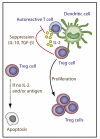Interleukin-2 receptor signaling: at the interface between tolerance and immunity
- PMID: 20732639
- PMCID: PMC2946796
- DOI: 10.1016/j.immuni.2010.08.004
Interleukin-2 receptor signaling: at the interface between tolerance and immunity
Abstract
Interleukin-2 receptor (IL-2R) signaling regulates tolerance and immunity. Here, we review recent work concerning the structure, signaling, and function of the IL-2R, emphasizing the contribution of IL-2 for T cell-dependent activity in vivo. IL-2R signaling influences two discrete aspects of immune responses by CD8(+) T cells, terminal differentiation of effector cells in primary responses, and aspects of memory recall responses. IL-2 also delivers essential signals for thymic development of regulatory T (Treg) cells and later to promote their homeostasis and function. Each of these outcomes on T effector and Treg cells requires distinct amounts of IL-2R signaling, with low IL-2R signaling sufficient for many key aspects of Treg cells. Thus, tolerance is readily maintained and favored with limited IL-2.
Copyright 2010 Elsevier Inc. All rights reserved.
Figures



References
-
- Bachmann MF, Wolint P, Walton S, Schwarz K, Oxenius A. Differential role of IL-2R signaling for CD8+ T cell responses in acute and chronic viral infections. Eur. J. Immunol. 2007;37:1502–1512. - PubMed
-
- Battaglia M, Stabilini A, Migliavacca B, Horejs-Hoeck J, Kaupper T, Roncarolo MG. Rapamycin promotes expansion of functional CD4+CD25+FOXP3+ regulatory T cells of both healthy subjects and type 1 diabetic patients. J. Immunol. 2006;177:8338–8347. - PubMed
Publication types
MeSH terms
Substances
Grants and funding
LinkOut - more resources
Full Text Sources
Other Literature Sources
Research Materials

